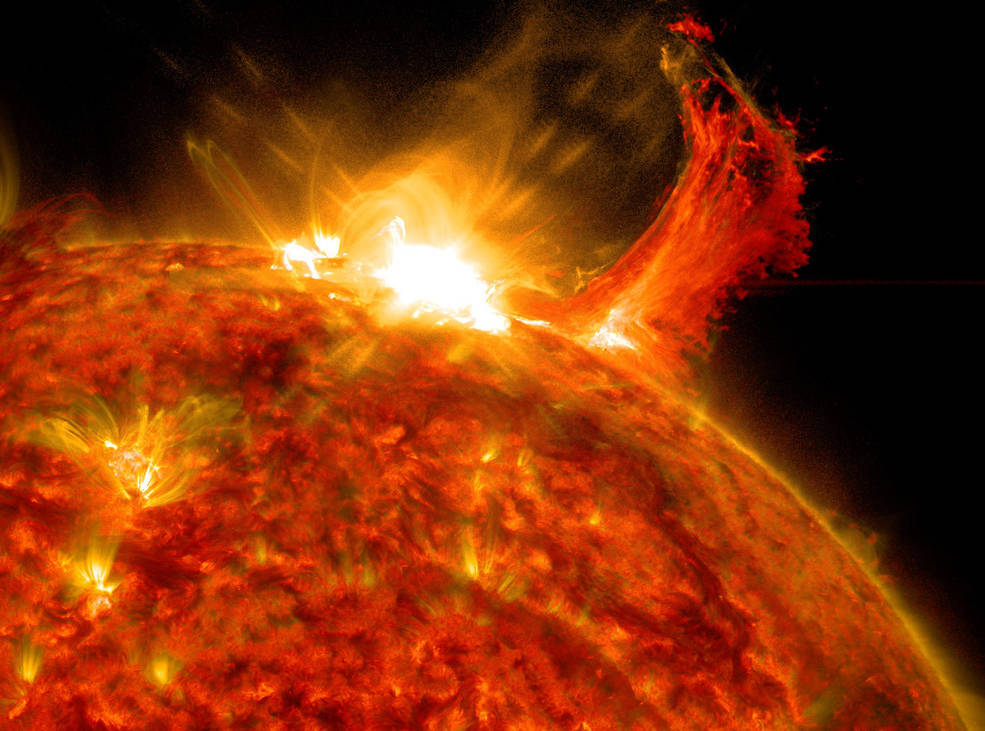31.03.2023
Like a tornado siren for life-threatening storms in America’s heartland, a new computer model that combines artificial intelligence (AI) and NASA satellite data could sound the alarm for dangerous space weather.
The model uses AI to analyze spacecraft measurements of the solar wind (an unrelenting stream of material from the Sun) and predict where an impending solar storm will strike, anywhere on Earth, with 30 minutes of advance warning. This could provide just enough time to prepare for these storms and prevent severe impacts on power grids and other critical infrastructure.

The Sun constantly sheds solar material into space – both in a steady flow known as the “solar wind,” and in shorter, more energetic bursts from solar eruptions. When this solar material strikes Earth’s magnetic environment (its “magnetosphere”), it sometimes creates so-called geomagnetic storms. The impacts of these magnetic storms can range from mild to extreme, but in a world increasingly dependent on technology, their effects are growing ever more disruptive.
For example, a destructive solar storm in 1989 caused electrical blackouts across Quebec for 12 hours, plunging millions of Canadians into the dark and closing schools and businesses. The most intense solar storm on record, the Carrington Event in 1859, sparked fires at telegraph stations and prevented messages from being sent. If the Carrington Event happened today, it would have even more severe impacts, such as widespread electrical disruptions, persistent blackouts, and interruptions to global communications. Such technological chaos could cripple economies and endanger the safety and livelihoods of people worldwide.
In addition, the risk of geomagnetic storms and devastating effects on our society is presently increasing as we approach the next “solar maximum” – a peak in the Sun’s 11-year activity cycle – which is expected to arrive sometime in 2025.
To help prepare, an international team of researchers at the Frontier Development Lab – a public-private partnership that includes NASA, the U.S. Geological Survey, and the U.S. Department of Energy – have been using artificial intelligence (AI) to look for connections between the solar wind and geomagnetic disruptions, or perturbations, that cause havoc on our technology. The researchers applied an AI method called “deep learning,” which trains computers to recognize patterns based on previous examples. They used this type of AI to identify relationships between solar wind measurements from heliophysics missions (including ACE, Wind, IMP-8, and Geotail) and geomagnetic perturbations observed at ground stations across the planet.
From this, they developed a computer model called DAGGER (formally, Deep Learning Geomagnetic Perturbation) that can quickly and accurately predict geomagnetic disturbances worldwide, 30 minutes before they occur. According to the team, the model can produce predictions in less than a second, and the predictions update every minute.
The DAGGER team tested the model against two geomagnetic storms that happened in August 2011 and March 2015. In each case, DAGGER was able to quickly and accurately forecast the storm’s impacts around the world.
Previous prediction models have used AI to produce local geomagnetic forecasts for specific locations on Earth. Other models that didn’t use AI have provided global predictions that weren’t very timely. DAGGER is the first one to combine the swift analysis of AI with real measurements from space and across Earth to generate frequently updated predictions that are both prompt and precise for sites worldwide.
“With this AI, it is now possible to make rapid and accurate global predictions and inform decisions in the event of a solar storm, thereby minimizing – or even preventing – devastation to modern society,” said Vishal Upendran of the Inter-University Center for Astronomy and Astrophysics in India, who is the lead author of a paper about the DAGGER model published in the journal Space Weather.
The computer code in the DAGGER model is open source, and according to Upendran, it could be adopted, with help, by power grid operators, satellite controllers, telecommunications companies, and others to apply the predictions for their specific needs. Such warnings could give them time to take action to protect their assets and infrastructure from an impending solar storm, such as temporarily taking sensitive systems offline or moving satellites to different orbits to minimize damage.
With models like DAGGER, there could one day be solar storm sirens that sound an alarm in power stations and satellite control centers around the world, just as tornado sirens wail in advance of threatening terrestrial weather in towns and cities across America.
Quelle: NASA


